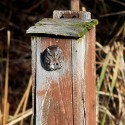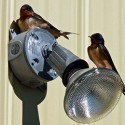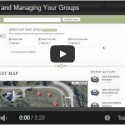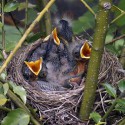 Photo ©
Keith Williams
Photo ©
Keith Williams

Roosting In a Winter Wonderland
by Robyn Bailey, NestWatch Project Leader
I have a few nest boxes around my house that have never been used for nesting, but I don’t dare relocate these duds. That’s because they have another purpose, for which I am happy to sacrifice them. They’re bird hotels, or if you prefer, “roost boxes.” That is, birds only use them in winter, tucking themselves in at night to keep warm and giving me great bird-watching opportunities all winter that I wouldn’t otherwise have.
It started with an Eastern Screech-Owl nest box three years ago. After checking this box all summer with binoculars, I didn’t see an owl face in the entrance hole until October. Then I saw it almost every day until March, after which sightings became a rare treat. But the following October, there it was again, sunbathing in the entrance hole. Then there’s the smaller box that is mounted on the side of my garage. No takers, but something was enlarging the entrance hole—I finally spotted the culprit, a Downy Woodpecker! Just about every night before sunset, the woodpecker flies to the box, peeks his head in before entering, then looks out one last time before settling down. Until recently, the small box on my back porch has never hosted anything. So imagine my surprise when an unidentified speeding bird-bullet came flying out of it as I walked onto the back porch and accidentally startled it (and it, me).
Most cavity-nesting birds will use nest boxes as a warm, dry place to sleep at night. Some roost individually, such as the Downy Woodpecker, but others, such as bluebirds, will roost in groups. Cavity roosting, especially in groups, can reduce heat loss, which in turn helps survival. In a study conducted in 1961, S. C. Kendeigh estimated that as much as 11% less energy may be burned by birds sleeping in cavities than out on a limb.
Watching your birds come home to roost at night, or in the morning in the case of owls, can be a lot of fun. So don’t be discouraged if birds aren’t nesting in some of your boxes; they may be roosting in them! How can you tell? A box that is used for roosting will contain feathers and droppings. If you really want to provide the five-star treatment, you can also build your own roost box for small songbirds that is specifically designed to minimize heat loss and accommodate groups of sleeping birds.

Attention Barn Swallow Study Participants
If you enrolled in our special Barn Swallow light pollution study earlier this year, but haven’t yet submitted your data, it’s not too late! You can still enter your breeding data via NestWatch, and your light pollution data via our supplemental survey.
It’s not too late to collect supplemental data on light pollution at your Barn Swallow nest site(s). In fact, it is easier now that the sun sets earlier. Simply follow the instructions that were emailed to enrollees, and look for the constellation Perseus by December 20. Click here for instructions on how to recognize Perseus.
Once you’ve submitted your Barn Swallow nesting data and your light pollution data, consider sharing a photo of your Barn Swallow nests. We’ve created a special category for you in our photo sharing tool. Upload a photo here.

Data Entry Improvement
For those of you with many nest sites to monitor, you probably know that Groups are a useful way to manage data and save time. If you’re not yet taking advantage of the groups tool, here’s how to start.
Several NestWatchers pointed out, and we agreed, that it would be really nice if your nest map would stay within the group filter you were working in until you changed it. We’re pleased to announce that now it does!
If you choose a group, e.g., “campus nest boxes,” and filter your map to only show those nest sites, then those are the sites you’ll see until you choose a different filter. You no longer need to re-select your group every time you stray from the Your Data page.
Remember to wrap up your data entry as soon as possible if you want to get counted in our January results recap!

Happy Holly-Days
The Cornell Lab of Ornithology will be closed December 25–January 4, for winter break. We’ll be back Monday, January 5. If you need assistance with NestWatch during that time, please see our FAQs and Data Entry Tutorial Videos.